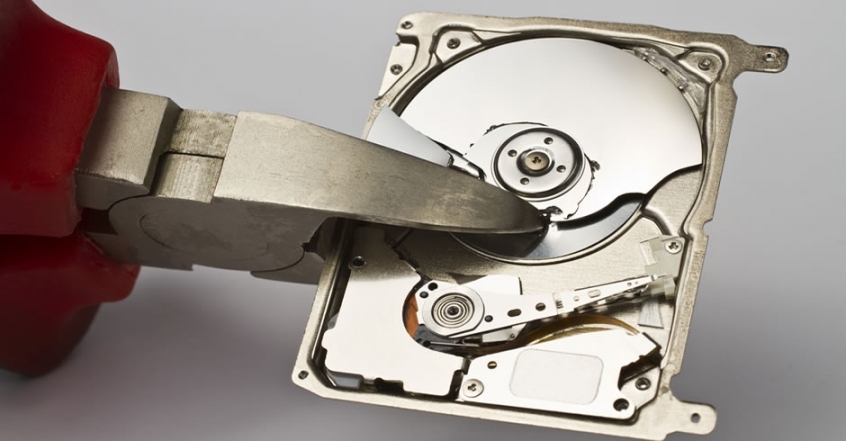In our last blog,we discussed the importance of being able to securely and permanently erase end-of-life data.Whether you’re working for a company that has legal obligations to destroy customers’ personal information after a certain timeframe, or you’re looking to sell an old smartphone on eBay and want to make sure nobody digs up your selfies, it pays to know how to do the job properly. And yet this is often a source of confusion – lots of consumers and businesses hold misconceptions about what constitutes secure data destruction and what doesn’t.
Formatting a disk, for example, won’t actually wipe it – it just removes the existing file system and generates a new one, which is analogous to throwing out a library catalogue when you really want to clear out the library itself. What’s more, taking a hammer to your hard drives is no guarantee – however unlikely – that someone with enough time on their hands won’t be able to reassemble the platters and transcribe the data.
So, how can consumers and businesses achieve peace of mind that their sensitive information won’t be coming back to haunt them after it’s been deleted? There are actually a few different fail-safe data destruction methods that have the approval of international governments and standards agencies, which vary wildly in cost and come with their own particular advantages and disadvantages. Here are three of the most important.
Method 1: Data erasure software
One of the simplest ways to permanently erase data is to use software. Hard drives, flash storage devices and virtual environments can all be wiped without specialist hardware, and the software required ranges from free – such as the ‘shred’ command bundled with most Unix-like operating systems – to commercial products.
While different data destruction applications use different techniques, they all adhere to a single principle: overwrite the information stored on the medium with something else. So, a program might go over a hard drive sector by sector and swap every bit for a zero, or else with randomly generated data. In order to ensure that no trace of the original magnetic pattern remains, this is typically done multiple times – common algorithms include Scheier seven-pass, as well as the even more rigorous, 35-pass Gutmann method.
Unfortunately, there are a few drawbacks to software-based data erasure. For one, it’s fairly time-consuming. Then, perhaps more significantly, there’s the fact that if certain sectors of the hard drive become inaccessible via normal means, the application won’t be able to write to them. Nonetheless, it’ll be possible for someone with the right tools to recover data from a bad sector.
Obviously, software-based data erasure also hits a snag when you want to destroy information stored on media that can only be written to once, such as most optical discs.
Method 2: The degausser
The days of cathode ray tubes might be a distant memory, but you probably remember what happened when you put a strong magnet next to an old TV set or computer monitor – the electrons firing towards the back of the screen would be pulled off course, resulting in distorted colours. To combat this, those devices contained degaussing coils – components designed to reduce or remove undesirable magnetic fields.
This process is also used to render data unrecoverable from retired hard drives and other magnetic media. A modern degausser is basically a giant box that generates a powerful magnetic field, throwing the medium’s existing magnetic domains into disorder. This is typically extremely trustworthy – there’s one caveat in that state-of-the-art hard drives are denser than their forebears and therefore require more magnetic force to fully degauss, but the current generation of degaussers should continue to be fit for use for a while yet.
Degaussing does, unfortunately, have a couple of disadvantages. For a start, it’s effective on magnetic media and magnetic media only. A degausser might be powerful enough to wipe a 100-terabyte hard drive, but put a flash storage device in there and it’ll come out unharmed.
Secondly, degaussed hard drives can’t be reused, so it’s not an ideal solution for companies looking to recycle or sell their hardware.
Method 3: Physical destruction
Finally, physically destroying the media is an option, though as discussed above, this isn’t always as fail-safe a method as it seems. A hard drive can sustain significant damage before the data contained therein is rendered irretrievable. In fact, even if the spinning platters inside are shattered, it’s theoretically possible that someone might put the parts together and recover the contents.
As such, simply snapping a hard drive in half isn’t a suitable technique for permanently erasing end-of-life data. If a company goes down the physical destruction route, it should ensure that the media is shattered into as many pieces as possible – most professionals would recommend using a specialist hard drive shredder.
For devices that use flash memory, the process is a little different. If the memory chip itself is destroyed, the data can’t be recovered. But if it survives, it can be transplanted into another circuit board with a fresh controller chip and the information can be accessed without much trouble.
In summary: it’s easy to assume that physically destroying media is a guaranteed way of securely erasing the data, but that’s not always the case. Doing the job properly is often as time-consuming as any other method and requires no less rigour.
Reference: http://blog.krollontrack.co.uk/top-tips/3-permanent-ways-erase-data/





